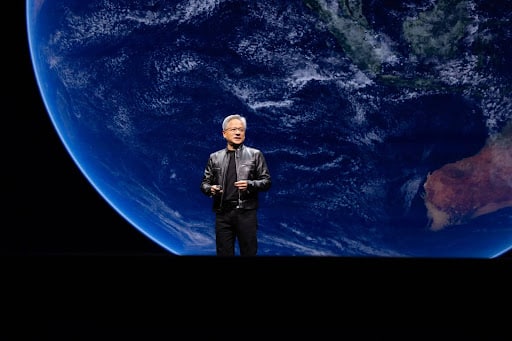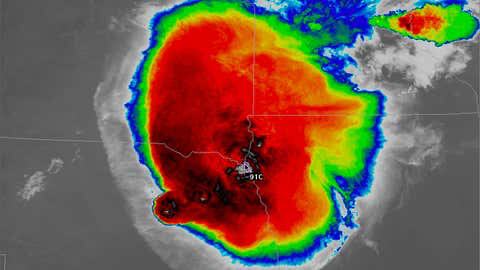As hurricanes, tornadoes and other extreme weather events occur with increased frequency and severity, it’s more important than ever to improve and accelerate climate research and prediction using the latest technologies.
Amid peaks in the current Atlantic hurricane season, NVIDIA Research today announced a new generative AI model, dubbed StormCast, for emulating high-fidelity atmospheric dynamics. This means the model can enable reliable weather prediction at mesoscale — a scale larger than storms but smaller than cyclones — which is critical for disaster planning and mitigation.
Detailed in a paper written in collaboration with the Lawrence Berkeley National Laboratory and the University of Washington, StormCast arrives as extreme weather phenomena are taking lives, destroying homes and causing more than $150 billion in damage annually in the U.S. alone.
It’s just one example of how generative AI is supercharging thundering breakthroughs in climate research and actionable extreme weather prediction, helping scientists tackle challenges of the highest stakes: saving lives and the world.
NVIDIA Earth-2 — a digital twin cloud platform that combines the power of AI, physical simulations and computer graphics — enables simulation and visualization of weather and climate predictions at a global scale with unprecedented accuracy and speed.

In Taiwan, for example, the National Science and Technology Center for Disaster Reduction predicts fine-scale details of typhoons using CorrDiff, an NVIDIA generative AI model offered as part of Earth-2.
CorrDiff can super-resolve 25-kilometer-scale atmospheric data by 12.5x down to 2 kilometers — 1,000x faster and using 3,000x less energy for a single inference than traditional methods.
That means the center’s potentially lifesaving work, which previously cost nearly $3 million on CPUs, can be accomplished using about $60,000 on a single system with an NVIDIA H100 Tensor Core GPU. It’s a massive reduction that shows how generative AI and accelerated computing increase energy efficiency and lower costs.
The center also plans to use CorrDiff to predict downwash — when strong winds funnel down to street level, damaging buildings and affecting pedestrians — in urban areas.
Now, StormCast adds hourly autoregressive prediction capabilities to CorrDiff, meaning it can predict future outcomes based on past ones.
A Global Impact From a Regional Focus
Global climate research begins at a regional level.
Physical hazards of weather and climate change can vary dramatically on regional scales. But reliable numerical weather prediction at this level comes with substantial computational costs. This is due to the high spatial resolution needed to represent the underlying fluid-dynamic motions at mesoscale.
Regional weather prediction models — often referred to as convection-allowing models, or CAMs — have traditionally forced researchers to face varying tradeoffs in resolution, ensemble size and affordability.
CAMs are useful to meteorologists for tracking the evolution and structure of storms, as well as for monitoring its convective mode, or how a storm is organized when it forms. For example, the likelihood of a tornado is based on a storm’s structure and convective mode.

CAMs also help researchers understand the implications for weather-related physical hazards at the infrastructure level.
For example, global climate model simulations can be used to inform CAMs, helping them translate slow changes in the moisture content of large atmospheric rivers into flash-flooding projections in vulnerable coastal areas.
At lower resolutions, machine learning models trained on global data have emerged as useful emulators of numerical weather prediction models that can be used to improve early-warning systems for severe events. These machine learning models typically have a spatial resolution of about 30 kilometers and a temporal resolution of six hours.
Now, with the help of generative diffusion, StormCast enables this at a 3-kilometer, hourly scale.
Despite being in its infancy, the model — when applied with precipitation radars — already offers forecasts with lead times of up to six hours that are up to 10% more accurate than the U.S. National Oceanic and Atmospheric Administration (NOAA)’s state-of-the-art 3-kilometer operational CAM.
Plus, outputs from StormCast exhibit physically realistic heat and moisture dynamics, and can predict over 100 variables, such as temperature, moisture concentration, wind and rainfall radar reflectivity values at multiple, finely spaced altitudes. This enables scientists to confirm the realistic 3D evolution of a storm’s buoyancy — a first-of-its-kind accomplishment in AI weather simulation.
NVIDIA researchers trained StormCast on approximately three-and-a-half years of NOAA climate data from the central U.S., using NVIDIA accelerated computing to speed calculations.
More Innovations Brewing
Scientists are already looking to harness the model’s benefits.
“Given both the outsized impacts of organized thunderstorms and winter precipitation, and the major challenges in forecasting them with confidence, the production of computationally tractable storm-scale ensemble weather forecasts represents one of the grand challenges of numerical weather prediction,” said Tom Hamill, head of innovation at The Weather Company. “StormCast is a notable model that addresses these challenges, and The Weather Company is excited to collaborate with NVIDIA on developing, evaluating and potentially using these deep learning forecast models.”
“Developing high-resolution weather models requires AI algorithms to resolve convection, which is a huge challenge,” said Imme Ebert-Uphoff, machine learning lead at Colorado State University’s Cooperative Institute for Research in the Atmosphere. “The new NVIDIA research explores the potential of accomplishing this with diffusion models like StormCast, which presents a significant step toward the development of future AI models for high-resolution weather prediction.”
Alongside the acceleration and visualization of physically accurate climate simulations, as well as a digital twin of our planet, such research breakthroughs signify how NVIDIA Earth-2 is enabling a new, vital era of climate research.
Learn more about sustainable computing and NVIDIA Research, a global team of hundreds of scientists and engineers focused on topics including climate AI, computer graphics, computer vision, self-driving cars and robotics.
Featured image courtesy of NASA.
See notice regarding software product information.
